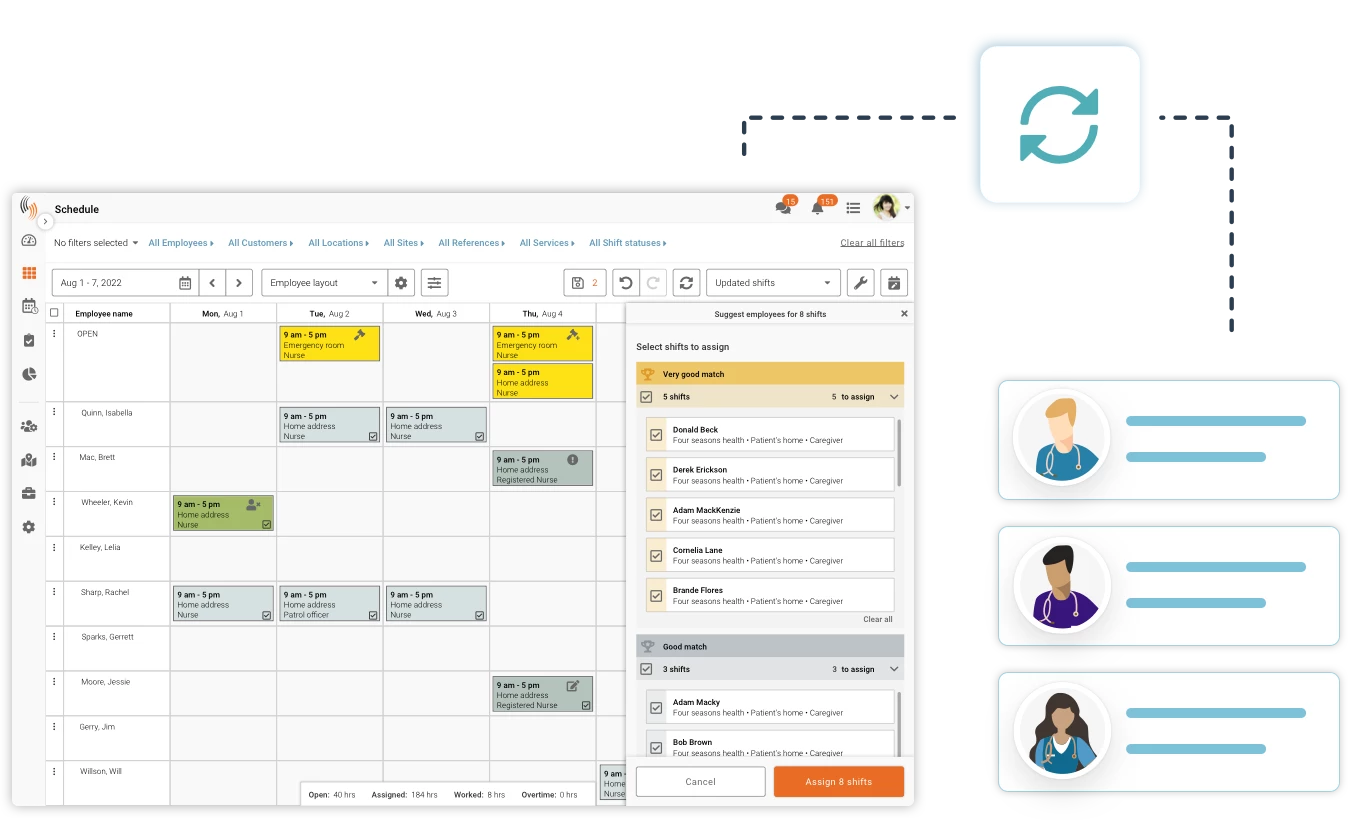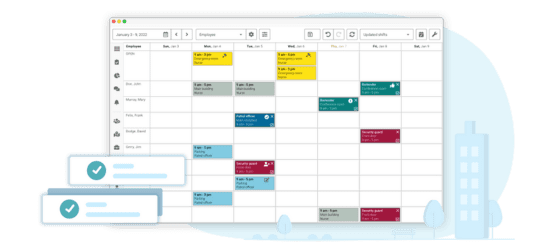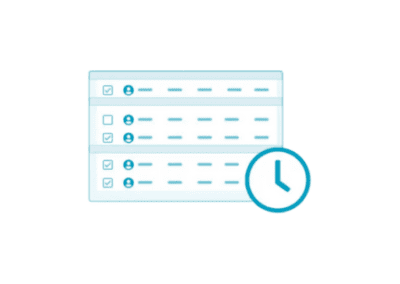If you have a larger workforce, creating an employee schedule isn’t always easy. There are many ways to schedule your staff, from traditional pen & paper to more automated ways. One of these automated options is self-scheduling.
What is Self-Scheduling?
Self-scheduling is when schedulers allow employees to essentially choose their shifts. The scheduler creates open shifts and the employees are then able to self-select shifts they are eligible for and able to work. Self-scheduling takes the burden off the schedulers and gives employees much more autonomy while providing flexibility for everyone involved. Celayix’s self-scheduling ensures that shifts are only filled by qualified staff fitting business needs.
How Does Self-Scheduling Work?
When a scheduler or manager is creating a shift schedule, they can decide to leave all or some shifts “open” or unassigned (pictured below in yellow). Then, they can release them for self-scheduling. Employees can then view any open self-scheduling shifts they are qualified for in their mobile app. If they are available to work they can claim whatever shifts they would like, filling the open shift while making sure all business rules and qualifications are still followed. Unlike shift bidding, self-scheduling is managed on a first-come-first-served basis. Self-scheduling still takes into account all business rules, including overtime, making it the best of both worlds for schedulers.
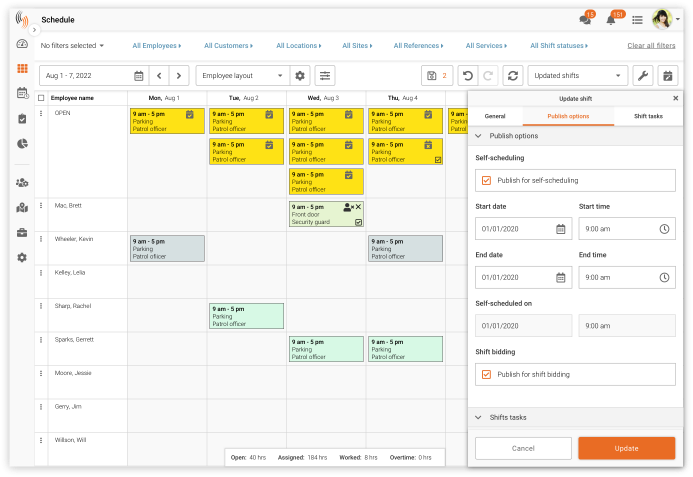
With Celayix, once the employer has created all of the shifts that need to be filled, they can send out a notification to their employees and invite them to claim them. With the Celayix platform, supervisors can even go as far as creating specific groups of employees that they would like to be notified about open shifts first. This gives them the option to further control the selection process with automation. Employees are notified through their mobile app, and can claim their chosen shifts with the touch of a button. After the employee has chosen their shifts, both the scheduler and the employee will receive a confirmation message.
Self-scheduling does two things:
- Allows you to create schedules much faster
- Give employees more freedom to achieve a strong work-life balance.
Who can use Self-Scheduling?
Self-scheduling is already the norm in a lot of industries. It is becoming very popular in any type of shift work that works on variable or static schedules, such as the hospitality industry. Another example is healthcare. The healthcare industry is a prime example of how self-scheduling can be implemented, widely accepted, and benefit both managers and staff members. It helps reduce nurse turnover rates and costs operating as a tool for recruitment and retention. The best part of self-scheduling is that any industry where employees work varying shifts/days can incorporate self-scheduling into their process. Here are some examples of industries we have seen successfully implement self-scheduling;
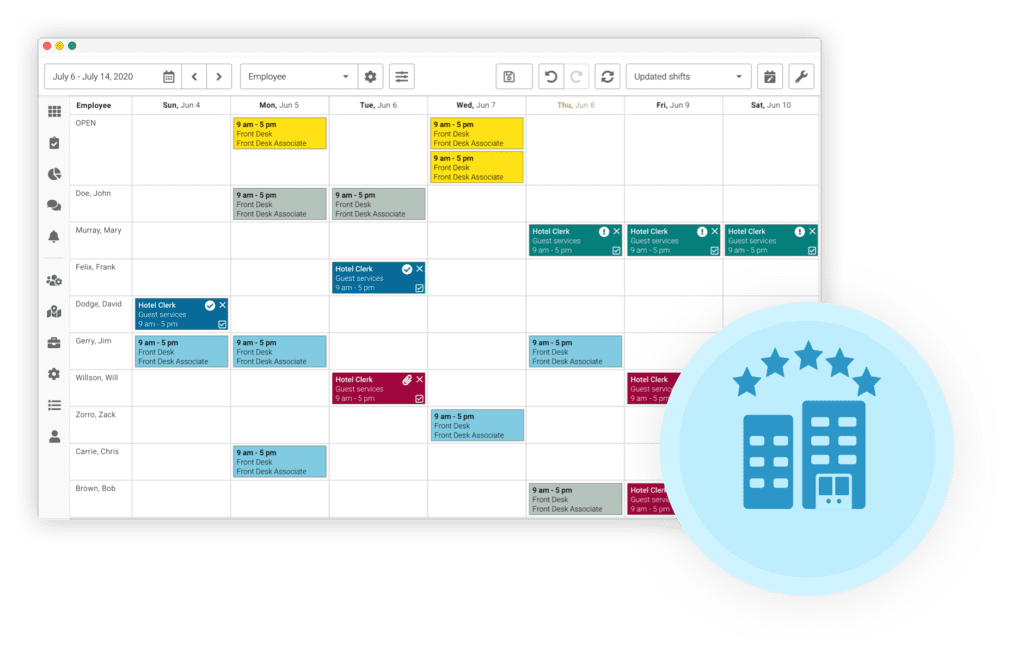
- Healthcare
- Security
- Manufacturing
- Retail
- Hospitality
- Cleaning Services
- Travel
- And more
Just about any industry with multiple shifts can benefit from introducing self-scheduling. Read on to learn more about the specific benefits.
Benefits of Self-Scheduling
80% of workers would choose a job that offers flexible scheduling over those that don’t.
Research from International Workplace Group
Improved Employee Morale & Retention
Employees can take control of their lives with self-scheduling while staying committed to their employer and ensuring shifts are filled. While choosing shifts, employees can factor in their preferences, needs, and other requirements. In fact, according to QuickBooks, the number 1 challenge faced by shift workers in the US is having enough time for their hobbies, followed by finding time to see friends, exercise, eat well, and get a good night’s sleep. As stated in a previous blog, autonomy and a healthy work-life balance can lead to increased employee morale and retention.
With a greater amount of freedom over their work schedules, employees are likely to enjoy their jobs more. They will also be more emotionally invested in your company. It’s also worth noting that offering self-scheduling may aid you in attracting the best talent to your organization. Research from the International Workplace Group found that 80% of workers would choose a job that offers flexible scheduling over those that don’t. This makes self-scheduling a win-win for multiple aspects of the organization.
Increased Productivity

Following on from how self-scheduling can improve employee morale, it will also lead to increased productivity. The improved work-life balance that your employees will experience from self-scheduling will have a domino effect on other aspects of their work lives. Improving work-life balance has been proven to reduce stress, prevent burnout, improve mental health & well-being, and improve motivation. All of these factor into employee output. When an employee feels balanced, they will be much more productive and committed to their job.
Reduced Absenteeism
Absenteeism is a huge issue for organizations today. Typically, factors such as family reasons, depression, stress/burnout, and poor punctuality contribute to the problem of absenteeism. Offering flexible options such as self-scheduling decreases the likelihood of employees missing shifts, or even arriving late. When they select their own shifts, they’ve likely accounted for any reasons that would prevent them from turning up on time. Absenteeism impacts both productivity & profitability. So, any steps that you can take to avoid or reduce it should be a high priority.
Save Time Scheduling
By allowing employees to self-schedule, schedulers do not have to spend as much time combing through lists of employees and factoring in overtime, availability, and qualifications. In general, introducing a shift scheduling platform like Celayix can reduce your scheduling time by 95%. We’ve helped companies reduce their scheduling time by 2 weeks! By spending less time and effort on creating and maintaining schedules, you free up time and effort that can be put into other areas of your business and improve your bottom line. Not only will you save time, but you save money on things like overtime and scheduling errors. If you want to know how much money you could save with Celayix, check out our amazing Cost-Benefit-Analyzer!
FREE UP MANAGEMENT RESOURCES
Creating an employee schedule for shift/hourly workers is no easy feat. It is time-consuming and takes resources away from other business areas. When you hired or promoted your managers, you surely didn’t want them wasting time creating schedules? You wanted them to lead a time, improve operations or scale your business, right?
With self-scheduling, managers spend significantly less time creating and managing schedules – meaning they are free to direct their resources into other business areas. They no longer have to spend as much time combing through lists of employees and factoring in overtime, availability, and qualifications. With managers free to focus efforts elsewhere, you should experience improved productivity, smoother operations, and even boosted team morale.
ATTRACT TOP TALENT

It’s no secret that the labor market is very competitive right now from the perspective of an employer. Employees are no longer at the mercy of businesses and are much more diligent when choosing where to work. This is on top of the extreme labor shortages on the back of the pandemic. Employers need to put their best foot forward when looking to hire new staff.
Self-scheduling will definitely help you attract prospective employees. In fact, 72% of people looking for a job believe that work-life balance is an important factor to consider. Given that self-scheduling is a sure-fire way to help employees achieve that balance, you might be missing out on some of the top talent in your field by ignoring it! Having the right employees is absolutely crucial to being a successful business. They are the ones interacting with customers/clients, producing the product/service you offer and they essentially represent your business. Using self-scheduling as a bargaining chip when trying to attract new, top talent is a great competitive advantage to have.
Why Choose Celayix for Your Self-Scheduling Needs?
Celayix is considered one of the best self-scheduling solutions for several reasons:
- Flexibility: Celayix’s self-scheduling solution is highly customizable. It can be tailored to fit the needs of different organizations, industries, and job types.
- User-Friendly: The platform is designed with a user-friendly interface that makes it easy for employees to view schedules, make changes, and communicate with their managers.
- Automated Rules: Celayix’s self-scheduling solution is highly automated and can be set up with rules and requirements to ensure compliance and fairness.
- Real-time updates: The platform is updated in real-time, allowing managers and employees to view the most up-to-date schedules and make changes as needed.
- Integration: Celayix’s self-scheduling solution can be integrated with other HR systems, payroll, and billing systems, making it easy for organizations to manage all aspects of workforce management in one place.
Overall, Celayix’s self-scheduling solution is highly effective at optimizing scheduling processes and improving workforce management efficiency, which is why it’s considered one of the best in the market.
Video: Self-Scheduling & its Benefits Explained:
How to Implement Self-Scheduling
Introducing self-scheduling isn’t just as easy as flipping a switch and hoping for the best. It will look different for every organization, but there are some things that you should definitely consider before making the change.
Keep Your Staff Informed
It’s always worth consulting your employees before making any big scheduling changes that will affect them, even if it is for the better. Springing unexpected changes on them may create a negative association before they’ve learned about how those changes can benefit them. Once everyone has been informed and your staff is on board, the next step is to train them on the new process. Even though a quick memo can do this step, many organizations miss it making it difficult for employees to know how/what to do.
Why does this matter? Well, without proper training, and without employees having a solid understanding of the processes involved in self-scheduling, you may end up creating more work for yourself as a scheduler. Obviously, this is the opposite of what you’re hoping to achieve. When employees don’t understand a new process, they tend not to engage with or make use of it.
Make Objectives Clear
To make sure the introduction of self-scheduling goes well for your organization we suggest organizations introduce the new scheduling process to the team, with clear objectives of how you want the process to work. Do you want your entire schedule to be self-scheduled? Will you allow employees to self-schedule their entire work week? These are all important considerations, and important for you to provide clarity on. Once employees understand the objective of self-scheduling, and the process itself, it’s also important to ensure that they are comfortable using the software by sending a quick memo, email or by sending one of our Get Started guides for employees. As straightforward as it may seem, it’s best to assume that everyone is learning from scratch. This will avoid issues further down the road.
The final step here is to welcome feedback from both your employees and schedulers on how the process is going. Giving your team an opportunity to have their voices heard, will further amplify the positive results that can be achieved with self-scheduling, and provide the smoothest experience possible for everyone involved.
Maintain a Positive Attitude
Leading by example is the best way to introduce big changes in any organization. Encourage senior managers to embrace self-scheduling, and more importantly to encourage it. It’s also a great idea to openly discuss the benefits of self-scheduling for employees. This will make them feel more supported in their search for that work-life balance that everyone is in need of. By supporting self-scheduling, the unified adoption of it throughout your company should be seamless.
Industry Example: How to Utilize Self-Scheduling for Nurses
With the ongoing challenges the healthcare industry faces in retaining nurses, it’s become a major priority to make all working environments as convenient as possible. During an unprecedented period, one tool that has given nurses some much-needed flexibility is self-scheduling.
An optimized schedule has always been important for healthcare facilities. And more and more are refining their processes to empower nurses with greater control over their work life balance. A healthcare facility operating 24 hours a day means that there will be great demand for nurses around the clock. If self-scheduling is utilized to its greatest effect, it can ensure that they aren’t working those same destructive shift patterns that are harming their mental and physical health. We’re going to look into how the healthcare industry can best utilize self-scheduling to optimize its entire operation. But before, let’s take a look at what it is.
HOW DOES IT BENEFIT NURSES?
Using employee scheduling software will allow nurses to choose the shifts they work by selecting them in an app that’s personal to them. Anybody who contributes to creating their own schedule is far more likely to adhere to it. And the simplicity of planning your schedule through the click of a button is something that all nurses will value immensely.
But its not just great for the nurses. It’s great for everybody.
STREAMLINING THE ENTIRE SCHEDULING PROCESS
When you’re using self-scheduling, it’s important that it can communicate with other tools in your schedule to help cope with change. Let’s look at some:
Shift drop – There’s going to come a multitude of times when a nurse wants to drop a shift they’ve already self-scheduled for. Employee scheduling software will allow you to use a shift drop tool which can recreate the shift as open.
In-app chat – Got an issue with an upcoming shift or while on shift? This will give nurses an easy way to communicate any preferences or issues they may have when it comes to any of their shifts. This will help supervisors to plan accordingly.
Autofill – A dropped shift will mean that a new shift now needs to be covered. May supervisors choose autofill as a quick fix. You can create rules which help to decipher the best-fit replacement who is available to work the shift.
Whichever tools you choose to use, it’s important that nurses are treated fairly.
So, how should you utilize self-scheduling for nurses?
Offering your nurses self-scheduling can strike the perfect balance between filling your schedule and keeping a happy and healthy workforce at its most productive. Giving them autonomy over their schedule helps to boost their morale and give them the work-life balance they deserve. On the other hand, the healthcare industry will be benefitting from a productive workforce that are motivated to make their efforts count. But in order to utilize self-scheduling at it’s very best, healthcare facilities will need to ensure they’re operating with a best-of-breed employee scheduling software.
As the healthcare industry was forced to adapt to unprecedented levels of demand, employee scheduling software remained a vital piece of software that helped to navigate them throughout. Even during a more recent and stabilized period, it’s still at the forefront of every scheduling decision healthcare supervisors need to make.
Self-scheduling will always provide an extra level of freedom to both nurses and their supervisors. But no matter what kind of freedom you’re willing to give, it needs to be controlled. If you integrate an employee scheduling software that allows you to best utilize your self-scheduling for nurses, then it also has the capacity to optimize your entire operation. It all starts with choosing the right platform to take your performance to the next level.
So, now you know what self-scheduling is and how it could benefit both you and your employees. The desire for work-life balance has been on the rise for the last 10 years and isn’t going anywhere. Employers that fail to adapt to the changing needs of their employees will inevitably fail to retain those employees or attract new talent.
So why wait? If you’d like to introduce self-scheduling or shift bidding into your business, we want to help. Get in touch with one of our solution advisors and let us help you improve your scheduling process.



